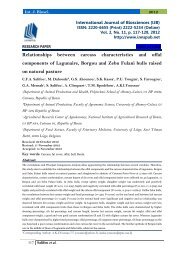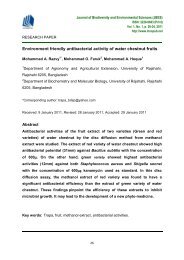Int. J. Biomol. & Biomed - International Network for Natural Sciences
Int. J. Biomol. & Biomed - International Network for Natural Sciences
Int. J. Biomol. & Biomed - International Network for Natural Sciences
Create successful ePaper yourself
Turn your PDF publications into a flip-book with our unique Google optimized e-Paper software.
22 <strong>Int</strong>. J. <strong>Biomol</strong>. & <strong>Biomed</strong>.<br />
Discussion<br />
The LD50 value of the aqueous leaf extract of S.<br />
radiatum (ESera), determined with the method of<br />
Miller and Tainter (1944) and that of Dragsted and<br />
Lang (1957) were 169.9 ± 15 mg/kg b.w. and 184.2 ± 21<br />
mg/kg b.w., respectively. The values were statistically<br />
very close. According to the classification of Diezi<br />
(1989), ESera has a low toxicity. The toxicity of ESera<br />
was nearly equal to those of Caesalpinia bonduc<br />
(Caeasalpiniaceae), a uterotonic plant, and Bridelia<br />
furruginea (Euphorbiaceae) which had a LD50 of<br />
166.66 mg/kg b.w. and 167 mg/kg b.w. , respectively<br />
Konan et al.<br />
(Datté and Offoumou, 2001; Néné-Bi et al., 2008). The<br />
toxicity of ESera was higher than that of Erythrina<br />
senegalensis (Fabaceae) which LD50-value was 1663<br />
mg/kg b.w. (Traoré et al., 2002). On the other hand,<br />
the toxicity caused by ESera was less important than<br />
those of other medicinal plants such as Securidaca<br />
longepedunculata (Polygalaceae) and Swartzia<br />
madagascariesis (Ceasalpiniceae) having LD50-values<br />
respectively equal to 64 mg/kg b.w. and 5.99 mg/kg<br />
b.w. (Traoré et al., 2002).<br />
Table 3. Dose-response effects of S. radiatum aqueous leaf extract on the rabbit ECG.<br />
ESera<br />
(mg/kg b.w.)<br />
Heart rhythm<br />
(Cycles/min)<br />
R-wave<br />
Amplitude (mV)<br />
Length of PQ<br />
interval (ms)<br />
Length of RT<br />
interval (ms)<br />
0 (Control) 225 ± 2.73 1 ± 0.06 40 ± 2.13 120 ± 3.75<br />
10 210 ± 3.8 ns 1 ± 0.05 ns 44 ± 2 ns 123 ± 4.6 ns<br />
15 188 ± 5.1 *** 0.95 ± 0.05 ns 51 ± 3.7 ns 125 ± 5.1 ns<br />
20 175 ± 2.4 *** 0.9± 0.09 ns 62 ± 2.65 *** 127 ± 2.7 ns<br />
25 152 ± 2.6 *** 0.8± 0.05 ns 72 ± 4.8 *** 132 ± 2.3 ***<br />
30 135 ± 3.47 *** 0.7 ± 0.5 * 78 ± 3.22*** 136.7± 2.54 ***<br />
S. radiatum aqueous leaf extract (ESera) induced negative inotrope and chronotrope effects on the global electric<br />
activity of the rabbit heart. Data shown are mean ± S.E.M. (n = 6). ns, p > 0.05 vs. control; * , p < 0.05 vs. control; ** , p<br />
< 0.01 vs. control; *** , p < 0.001 vs. control.<br />
Table 4. Reversible action of S. radiatum aqueous leaf extract on the rabbit ECG.<br />
Periods of<br />
registration<br />
(min)<br />
Heart rhythm<br />
(Cycles/min)<br />
R-wave<br />
Amplitude (mV)<br />
Length of PQ<br />
interval (ms)<br />
Length of RT<br />
interval (ms)<br />
0 (Control) 225 ± 2.73 1 ± 0.06 40 ± 2.13 120 ± 3.75<br />
0.5 210 ± 2.78 ns 0.8 ± 0.05 ns 56.7 ± 3.1 ** 133.3 ± 2.87 *<br />
1 180 ± 4.26 *** 0.7 ± 0.05 * 76.7 ± 3.12 *** 136.7 ± 2.54 **<br />
2 135 ± 3.47 *** 0.8± 0.07 ns 78 ± 3.22 *** 126.7 ± 2.91 ns<br />
5 165 ± 3.48 *** 0.9± 0.06 ns 53.3 ± 2.6 * 123.3 ± 2.69 ns<br />
10 230.5 ± 5.4 ns 1 ± 0.1 ns 41.5 ± 2.12 ns 120.5± 2.7 ns<br />
The values of the parameters showed that the action of ESera (30 mg/kg b.w.) on the rabbit ECG was reversible. Data<br />
shown are mean ± S.E.M. (n = 6). ns, p > 0.05 vs. control; * , p < 0.05 vs. control; ** , p < 0.01 vs. control; *** , p < 0.001<br />
vs. control.








